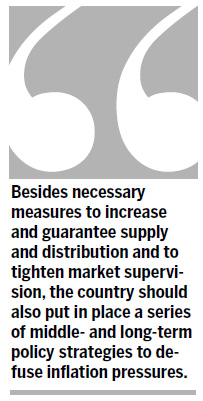Opinion
Putting the lid on inflation
By Zhang Xiaojing (China Daily)
Updated: 2011-05-24 13:56
 |
Large Medium Small |

Slower economic growth, better control of liquidity and changes in product structure will help tame rising prices
China's new round of inflation pressures is a combination of a variety of complicated internal and external, short-term and long-term factors.
While China's economy was hit by the global financial crisis, it quickly regained momentum following a series of stimulus packages and its average annual growth rate was 11.2 percent over the 11th Five-Year Plan (2006-2010) period.
But in order to fend off the harmful effects of the global financial crisis, China has pumped a large amount of monetary supply into the market over the past two years, brewing excessive liquidity in its economy.
Statistics show that the country's total financing volume, an important index to measure market fluidity, amounted to 15.1 trillion yuan ($2.3 trillion) in 2009 and 14.6 trillion yuan in 2010. This huge scale of financing is yet to unfold its full influence on the current level of prices, although the Chinese government has adopted a series of macroeconomic measures to tame inflation.
| ||||
Imported inflation has been a leading external factor fuelling China's inflation pressures. China is currently highly dependent on the import of some bulk commodities, especially energy and some primary raw materials, to fuel its fast-growing economy. It is more than 50 percent dependent on imports of oil, bronze and iron ores.
Since last year, prices of some bulk commodities have continued to rise in the international market with the considerable depreciation of the dollar, the resumption of global demand, excessive global liquidity and political turbulence in the Middle East, leading to increased import costs that further push up China's consumer price index (CPI).
The nation's accelerating urbanization and its pricing reforms have also served as middle- and long-term factors affecting China's ever-growing inflation pressures.
As the result of its rapid urbanization, the country's costs of labor, land, energy and other materials have continued to rise in recent years.
Since 2009, when different local governments began to raise their minimum wage standards, labor costs in parts of the country have increased by more than 20 percent, which, together with the rising prices of resources and growing distribution costs, has contributed to the recent price rises for domestic agricultural products.
China should regard stabilizing the current price level as its top priority this year. Besides necessary measures to increase and guarantee supply and distribution and to tighten market supervision, the country should also put in place a series of middle- and long-term policy strategies to defuse inflation pressures.
The Chinese government has lowered its gross domestic product (GDP) growth target to 8 percent for the year 2011 and to 7 percent on average for the 12th Five-Year Plan (2011-2015) period. The lower economic growth target demonstrates the high degree of attention the government is paying to better balancing the country's economic growth and inflation and to improving the quality and efficiency of its economic growth.
However, local governments are expected to have unprecedented enthusiasm for investment as a means of raising their political performance. This move, if not effectively curbed, will likely add to the nation's inflation pressures. Thus, China should take some pre-emptive measures to curb such an investment impulse in a bid to create favorable conditions for a soft landing of its economy.
Also the management of liquidity should be tightened to undercut the monetary factors behind the country's latest round of inflation pressures. China should further reduce its credit scale, which rocketed following its adoption of a series of large-scale stimulus packages aimed at easing the impact of the global financial crisis.
At the same time, effective measures should be taken to stop the continuous inflow of international hot money. As a move toward this end, the country should pay attention to imports and try to strike a balance in its international payments.
To acquire sustainable and rapid economic growth, China should also further deepen its pricing reforms and expedite the transformation of its long-controversial extensive development mode that is heavily dependent on simple investment expansion in a bid to form a market-based resources pricing mechanism.
Considering that price rises remain a long-term irreversible tendency, the government should refrain from excessive administrative intervention into the current management of inflation pressures, a move that could result in the distorting of prices and cause the market to fail to play its role.
The author is a researcher with the Institute of Economics under the Chinese Academy of Social Sciences.
| 分享按钮 |



